
|
Back to |
| The Front Page |
| The Game |
|
Why can't we keep
the American opening
and why do we have to
keep messing with it?
|
|||||||||
|
story and charts by Garth Eliassen, editor, National Croquet Calendar Posted November 12, 2006
|
|
||||||||
As founder and longtime editor of the National Croquet Calendar, Garth Eliassen has championed many causes, more often than not on the winning side. His passionate defense of the "balls out" strategy regularly employed by most top players of American rules croquet has extended over many years and several revisions of the USCA's rule book. While many informed observers predict that the new experimental rule will be used exclusively in novice-level games and will never be seen in regional and national tournaments, Eliassen fears that a rule he considers reactionary might somehow achieve currency in top-level competitions. The arguments he presents against this outcome are numerous and powerful. They also embody much of the "chess" of American croquet, so if you don't read carefully with the aid of the diagrams, you'll miss the point.
By the time this article is being read, the new 2006 version of the U.S. Croquet Association rule book will have been mailed out across the country. The new rules are officially effective November 20, 2006, after the conclusion of the National Seniors and Masters Championship at the National Croquet Center, which marks the end of the 2006 season for USCA title events. Much of the content of the new rule book consists of clarification to existing rules, minor changes, and a new paragraph-numbering format.
Strikers's ball can now do damage after the roquet
| Experimental Rule 17.1: Immediately in the Game |
|
An experimental rule may be used in USCA sanctioned events only if written
notice of the intention to use the rule is given on all player notification and
entry forms prior to a tournament. Here is the complete and exact wording of
Experimental Rule 17.1:
The game begins by each ball, in turn, beginning with blue, being placed
within the starting area. As soon as a ball is placed within the starting area,
it is in the game and live on all other balls which have already been placed in
the starting area. In using this Experimental Rule, players should assume
that all other references in the rule book to balls "in the game" or balls "not
in the game" be considered deleted.
|
The new rule is a little complicated, and more difficulties will probably emerge after a while when its consequences become apparent and differing interpretations begin to show up. As a member of the USCA Rules Committee, I was against the change because it always made sense to me that striker should be ball-in-hand immediately after a roquet, and I found this concept easier to absorb by beginners. When told that the striker's ball is immediately lifted and for all practical purposes disappears the moment of a roquet, novices could grasp the idea that all other balls moved by the "lifted" ball were replaced.
One flaw in the old rule, according to the proponents of the new version, was the problem of replacing to the exact spot other balls that had been moved. I rarely found that to be a problem in championship-level play (courtesy and agreement usually always prevail), but maybe it was difficult in other circles.
All-balls-alive opening reinstated as an option
The biggest problem in the new rule book is the reinstatement as an experimental rule of the controversial all-balls-alive opening. The alternate opening would be allowed in tournament play. This would eliminate the option of holding back balls in the American opening, thus eliminating much of our current strategy - especially at a high level of play - and much of the unique attraction of the American game.
When the modern American version of the rules was codified and published in 1976, concurrent with the formation of the USCA, Jack Osborn, whether through chance or by design, settled on a version of the game that is worthy to endure. He and his Long Island friends were somewhat familiar with the "Association" [International Rules] game known throughout the rest of the world, but they may not have known the details. The rules they adopted instead drew from the traditional American nine-wicket games that had been played and rose and fell in popularity, in various forms, since the mid-1880s, and the six-wicket version being played a century later in high society enclaves in Hollywood and New York.
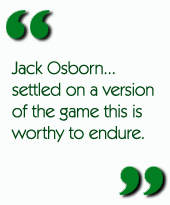
The Osborn rules differed significantly from the Association rules and established a version that in my opinion is superior in most respects to the international game.
When I introduce new players to the game in beginner clinics, I start out by explaining that the attraction of championship croquet (six-wicket) is that it is a game that emphasizes strategy and thinking over shotmaking ability; that in a game between players of relatively matching skill, the player who is thinking the best will always win, not the one shooting the best.
Of course, to avoid confusing the newcomers too much, I fail to mention that such is the case in American croquet, not in the Association game. To bring up a different version before they've even hit a few balls might not be wise; 45 minutes after I've started instruction, they will be already dizzy enough.
At the top level in the international game, all breaks and leaves are well known and routine (with occasional innovations), and it will always be the player who is shooting the best who wins. And there is no doubt that the Association version is home to and usually preferred by the highest ranked players in the world. Reg Bamford and Robert Fulford are the greatest players who have ever lived; with them, sextuples are routine, and they are engaged in a friendly competition with one another to continually drive the state of technical expertise to higher levels. But the skills of these two top players are continually being challenged by other precision international players, a few top Americans and Canadians, and no doubt some young upstarts who are just now walking onto courts and will soon be routinely playing octuple peels and striving for the holy grail of croquet: the one-turn win by the first ball in the second round of play.
The five main differences in American and International play
There are five main differences between the international version and American croquet. In Association croquet all balls are alive in the opening, you start each ball from one of two balklines, balls are replaced to one yard from the out-of-bounds line, the deadness achieved during a turn does not carry over to the next turn, and on each turn the player can decide which of his balls to play (no order of rotation). Most of these elements of Association croquet enable more aggressive play, and two of them - the one-yard line and no deadness carryover - strongly encourage it.
In the American rules, on the other hand, balls are not alive until #1 is cleared, balls start one yard from the first hoop, balls are replaced to nine inches from the out-of-bounds line, deadness carries over from turn to turn until the proper hoop is cleared, and the balls must be played in order of the proscribed color sequence.
All of these elements of American rules croquet - especially the nine-inch line and deadness that sticks - discourage aggressive and reckless play. A player must decide the benefit versus the risk of each move. To attack the opponent you must usually first go dead on partner, on the continuation shot you must hit the opponent ball without nudging it out of bounds, and if you misstep at any point during the attack your deadness will carry over until you clear your next hoop - with potentially devastating consequences.
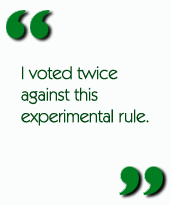
Making all balls alive at the start would shift the American game closer to the Association game - curtailing much of the strategy in American rules opening play. And that is precisely my problem with the new experimental rule 17.1, which gives tournament directors and managers the option of mandating that all balls are alive before clearing #1.
As a member of both the current rules committee and the USCA management committee, I voted twice against this experimental rule. In the rules committee, a few of us opposed the idea but did not prevail; in the management committee, I recognized the hard work of the rules committee but was the lone voter against the new rule book because it contained the optional experimental proviso.
A look at the development of American rules play
In the early 1980s, American players began to compete regularly with foreign players and started to become more familiar with the Association rules. At that time virtually everyone tried to run wicket #1 on their first turn. The standard American opening was: blue in to corner I, red in to corner II, black in to join blue giving a rush to corner II, and yellow in to join red. On the second round blue could rush black upcourt, attack the players, make #2, and set a break for partner. Because of this attacking advantage (and the advantage of choosing corner I), players winning the toss would always choose blue and black.
After getting beaten up enough in the above manner, red and yellow soon began to look for safer places to go after running wicket #1. First was corner IV. But then blue and black had two good options: one was to seize corner II, which was closest to the contested hoop; the other alternative was to put black's join on the south boundary, still giving a rush to the opponents.
Then if yellow joined red in corner IV, blue could attack and set the first break for black, either in the vicinity of corner IV or taking off from black and bringing the spent ball (yellow) back to the west side, also setting a break and leaving a difficult hit-in attempt for red.
Then red and yellow tried to find secure refuge in corner III. That was relatively safe, but if blue rushed black to #2 and cleared, then blue could again attack the opponents and try for a three-ball break.
All this time - and we're talking mostly about the early eighties here, at the latest, in top-level play - the other opening alternative with all four balls in the game was to dink around in corners, or hopscotch from corner to corner, playing a game of nerves and waiting to see who would assume the risk of partner deadness and attack first. Most of the time those early attacks would fail, and the player with the most patience would win the opening with the advantage of the opponent's deadness acquired in the failed attack.
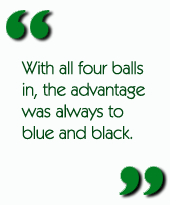
The biggest problem with all four balls in, is that the advantage was always to blue and black, and the first to play could determine the flavor of the game. But American competitors then were still under the influence of Association play, and felt that the height of croquet achievement was Association-type two-inning games with the "perfect" score of 26-2 (in Association rules it would be 26-0).
All four balls in also gives additional advantage to the stronger player, who is more likely to succeed in the opening attack; the weaker player is more likely to fail the attack or fail to clear #2 after a long sideline rush and positioning croquet shot.
The Arizona Croquet Club innovates by holding back yellow
Around this time, as American strategy began to develop, members of the Arizona Croquet Club (which by the way preferred to play the Association version and formed their own organization, the American Croquet Association, to promote it) began to experiment with a new American tactic. The one way to counter the routine opening rout by blue and black was simple: just hold back yellow, setting up at #1 instead of clearing.
Holding back yellow deprived the opponent of all four balls and negated the benefit of attacking first: if the opponent did attack, and screwed it up, yellow could enter the game, clearing #1 with control, and then feed on the debris.
The Chernobyl debuts to mixed reviews
In April 1986 I developed an opening that not only held back yellow, but in the second round put red out on the court north of #1 for the opponents to attack. An article on the new opening was published in the Spring 1987 edition of the Western Croquet Newsletter. At first most American players dismissed the Chernobyl Gambit as a stupid play - even though their continued attempts to attack red or disrupt yellow would usually end up in disaster and an accumulation of stifling deadness before even approaching #2.
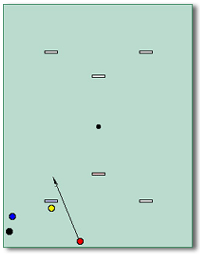 |
| The Chernobly Gambit - and other modern American openings - would no longer be played if tournament directors choose to adopt experimental rule 17.1 of the new edition of the Official USCA rulebook, effective November 21, 2006. The Chernoble and other openings which deliberately keep one or more balls out of the game take the first-turn advantage away from blue and black and equalize diferences between players of varying skill levels. |
Another advantage of the Chernobyl is that it served as an equalizer between players of differing skill levels as well as taking the initiative away from blue and black by allowing red and yellow to determine the type of opening to be played. After some players begrudgingly began to admit that the "balls outs" opening had possibilities, debate began about how to counter this opening, mostly spurred on by the 26-2 Association play aficionados who were furious about being denied their two-break games.
Alternatives proposed in the 1989 and 1992 rule books
Their defense against the strong opening for red and yellow afforded by keeping one of the balls out was simple: Just change the rules! The first attempt to ban the Chernobyl - and any other plays like it - by outlawing setting up at #1, was proposed for the new rule book being revised at the time. I argued against the experimental rule in the January-February 1989 Calendar, but in vain.
The 1989 rule book introduced no fewer than three experimental rules designed to keep players from setting up or blocking balls at #1. One rule said that a blocking ball could be marked, picked up, and replaced after the opponent's shot; version two required that a ball not clearing #1 be picked up and placed at the starting tee on its next turn; version three made all balls alive at the beginning of the game.
The debate continued through the publication of the 1992 rule book, but for that issue the opening alternative rules were pared down to two.
By then the opening repertoire for red and yellow had been enhanced by such versions as the Fleming Attack and the Center Gambit and its variations; and the Chernobyl was being played in championship divisions at tournaments across the country, often in the finals of National Championships.
Sanity returned to the rules committee when in 1995 the new rule book eliminated all references to optional experimental rules in the American opening. I was grateful and relieved that the battle seemed to be over.
But the opponents of the American opening persisted, and now we are back with an opening version that could destroy the uniqueness of the American game if it is widely adopted by tournament directors.
Proponents of the new (old) experimental rule argue that there would still be some strategy in the opening if all balls are alive, but that strategy would be limited to where you go to attack if you are blue and black and where you go to hide if you are red and yellow. I am reminded of what golfers say when I tell them about the intense strategy in croquet: "Hey, there's a lot of strategy in golf!" Several times I've responded, "Yeah, like what side of the fairway to put the ball on!" But that doesn't engender new players, and golfers will never appreciate croquet until they've tried it for a day.
The openings: traditional, defensive, and offensive
Basically, contemporary American openings can be divided into three general categories: traditional, defensive, and offensive.
The traditional openings involved all four balls clearing #1, briefly discussed earlier. A great variation to blue and black in corner I and red and yellow in corner IV was used by Australian Barry Chambers in the 1991 San Francisco Open. Normally, with blue having a rush on black to #2, we would think to take the rush, clear #2, rush to #3, clear #3, then rush to #4 and attack the opponents. But Chambers rushed from corner I to #2, cleared, then skipped #3 and rushed directly to #4. He then took off to the opponents in corner IV, roqueted the south ball and rushed the north ball upcourt to #3, cleared, and embarked on a four-ball break with his previously placed pioneer at #4.
Chambers' partner Neil Spooner, who served as pro at Sonoma-Cutrer for several years, had no fear in the American game and would attack regardless of where red and yellow were positioned. He once played a three-ball triple peel at the Meadowood Classic and pegged out for the win, and was well-known for gratuitously peeling opponents balls (for practice) as well as his own. While dinking around at Cutrer, Spooner would also practise clearing #1 and hitting balls in corner I. The result was that he achieved a high hit-in rate and several new attacks.
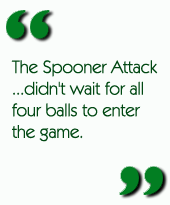
The Spooner Attack, which he debuted at Meadowood in 1988, didn't wait for all four balls to enter the game. Spooner chose blue and black, then cleared with blue and took corner I. The opponent cleared red and went to corner IV. Black cleared #1, hit blue in corner I, then Spooner played a cross-court split sending blue out of bounds to red in corner IV and loading #2 with black. With the tight wickets then being used at Meadowood, no one tried to clear #1 deep, and the opponent set instead, waiting to see what happened. What happened was that Spooner went around with blue, while cannoning yellow out of position at #1, and won shortly later.
Playing red and yellow when the opponent took corner I with blue, Spooner would go to corner II. Black would join blue with an upcourt rush. Then Spooner would clear #1 with yellow, hit blue in corner I, rush black upcourt, clear #2 and set up partner, and leaving the opponent with an impossible hit-in attempt from corner I. (Spooner would have wired the ball at #1 from corner I).
When Spooner owned corner I with red and the opponents were near corner IV, he would clear #1 with yellow, hit red, play a horrendous cross-court split loading #3 with red while going to the opponents, hit the danger ball, and rush the spent ball to #2, clear, and embark on a four-ball break.
After his tenure at Sonoma-Cutrer, Neil returned to Australia and retired from croquet. His impact on the American game is still felt, and his three-ball triple is probably the greatest game yet played in American rules. He was a brilliant strategist, as well as the first to win a championship match 26-1 in the American game. An ending score of 26-1 is now called a "Half Spooner." A "Full Spooner" would be 26-0. Spooner came to the U.S. as a legendary Association-rules player. By the time he left, he had come to prefer the American game.
All-balls-in openings
With the standard four-balls-in games, red and yellow can play somewhat defensively by taking cross-corner positions instead of joining on one of the boundaries. Being about a yard apart but on different boundaries in corner II, for instance, (red on the north boundary one yard from the corner and yellow on the east boundary one yard from the corner) can prevent the opponent from attacking with blue on the second turn and making #2 (can't get the rush). But it can't keep the opponent from attacking, taking the deadness, and setting up partner with a three-ball break.
The best play when attacking cross-cornered opponents at corner II is for blue to rush black as close as possible to the opponents, roquet the spent ball, then place it in black's vicinity, then roquet the danger ball and send it away to #3 or downcourt toward #4 while trying to stop to position to clear #2. If you can then clear the hoop, do it; if not, find a position with a peel possibility from black and wired from the danger ball'particularly if the danger ball is in the vicinity of #3 where the cross-court roquet would have higher probability. This combination - if missed by the hit-in attempt - will leave black with a three- or four-ball break and perhaps a straight peel attempt on partner, to clear deadness, at #2.
Other all-balls-in openings include red near the west boundary offering a tice to the opponent and an attack with yellow if the opponent joins partner (Peterson Gambit, National Championships, 1988) or Leo McBride's more recent version of a similar attack to corner I, the Caravan Gambit where red follows blue and black to corner IV, and the more outrageous but brilliant and complicated Burchfield Double Gambit where both red and yellow join blue and black in corner IV (International Challenge Cup, 1990).
Balls-out variations are numerous and still developing
By this time, the "modern openings" of holding back balls were becoming well-entrenched. Damon Bidencope, playing at Meadowood, experimented with holding back both balls, and nowadays "Bad Boy" Mik Mehas loves the out-game so much he sometimes blocks #1 with blue and holds back all the balls until he finds a good time to enter.
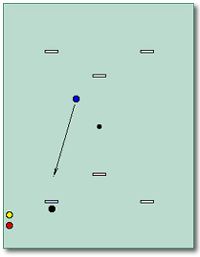 |
| In the Center Gambit, blue clears #1 and goes to the center of the court. If red fails to take the bait and instead of attacking retires to corner 1, black blocks and yellow - if successful in the jump - can join red. Then blue, on the first shot of the second turn, can set up in front of #1, effectively transposing to the Chernobyl for blue and black. |
The Chernobyl opening featured blue clearing #1 and going to corner I (the standard start); red clearing #1 and shooting out of bounds on the south boundary behind #1; then black joining blue, usually giving blue an upcourt rush toward #2; then yellow holding back and setting up in front of #1. Regardless of what blue does in the second turn, red shoots out on court in front of #1 (the gambit), offering a tice for blue and black.
The Chernobyl could give the opening advantage to the weaker player by forcing the opponent to take the initiative and first deadness: if blue and black rushed to #2 and failed to clear, yellow would clear #1, roquet red and load pioneer, then pick up the four-ball break waiting at #2; if blue and black rushed to #2 and cleared, blue would have to continue by rushing black to #3, shoot blue offcourt leaving black at #2 for yellow, or try a risky scatter shot sending both blue and black offcourt.
Reid Fleming developed a strong attack for the Chernobyl: in the Flemley Variation (Fleming-Arkley, 1986) instead of red going out on court in turn two, red could try to hit in at the opponents in corner I. If red hit the back ball, it had a rush to #2 and a three-ball break for yellow. If red missed, there wasn't much blue and black could do because yellow was poised at #1.
 |
| If red shoots at blue in the center of the court and misses, blue can set up in front of #2 on its next shot. If red hits blue and tries to roll up and clear #2 but fails, the Center Gambit can morph into the Vigil Version with red and blue battling at #2 and black and yellow battling at #1. Also, if red has tried to clear #2 off blue and failed, and black is successful with the block, blue will most likely have a wiring lift to red: blue can clear #2, then guard the hoop instead of advancing to #3. The final score could be a nerve-wracking 2-1. |
The Chernobyl was so successful that blue and black needed a similar version. The Center Gambit debuted at Meadowood in 1988 and featured blue clearing #1 and shooting to the center of the court somewhere between the peg and #6 (the best location depends on the skill level of the opponent). Red would then clear and usually take corner I; black would set, blocking; and yellow would try the jump or drive black away, leading to a two-in, two-out game.
The convolutions of the Center Gambit are many, and if the out-game is continued, black has the advantage in the oncourt game by being closer to #2. If yellow manages the jump and clears #1, it can join partner in corner I or shoot at black (a miss separates the opponents, a hit means a dangerous roll-up to hoop position at #2 with yellow ready to clear #1 with control). If yellow joins partner or misses blue's gambit, blue can set at #2 or set north of #1, effectively transposing to the Chernobyl Gambit for blue and black. If yellow hits blue, tries the roll-up to #2 and clangs the hoop, the opening gets complicated.
So complicated was the Center Gambit that another version, the Vigil Version of the Center Gambit (Willamette Croquet Club, 1990), was developed which featured patience, aggravation, and precision at #2 and could ultimately result in a 2-1 finishing score in a game that would focus entirely on defensive play for blue and black. I also introduced a new concept to the American game: the avoidance of wickets rather than attempting to make them!
If you change the opening, you weaken the game
The reason I mention all this is that these American openings (and others that may be developed) show the incredible intricacy possible in the current rules.
The Association game is an increasingly accessible alternative in America, with more events being held across the continent, including its the USCA's own national championship for International rules. For that reason alone, there is no need to move American play closer to the international version.
Most Association-rules games in the top divisions are nearly identical anyway, and the success of their execution depends on the skill of the player. All the top Association-rules players know the standard openings, breaks, leaves, and peels; and the pattern of most games is identical.
In American croquet, I have never seen - even at the top level - two games that were the same. And that is the fascination the unaltered American game offers, and its attraction.
We don't have to experiment. We don't have to change a thing.
Garth Eliassen was an early contributor to modern American strategy, developing the Chernobyl Gambit in April 1986, followed by the Center Gambit and the Vigil Version openings, as well as other specific plays unique to American croquet including the rush load, rover gambit, and the American promotion cannon. He has been publishing the National Croquet Calendar, a bimonthly journal on championship croquet, since January 1988. A list of strategy articles and back issues still available can be obtained from the National Croquet Calendar, PO Box 208, Monmouth OR 97361 or e-mail a request to eliassen@ados.net.